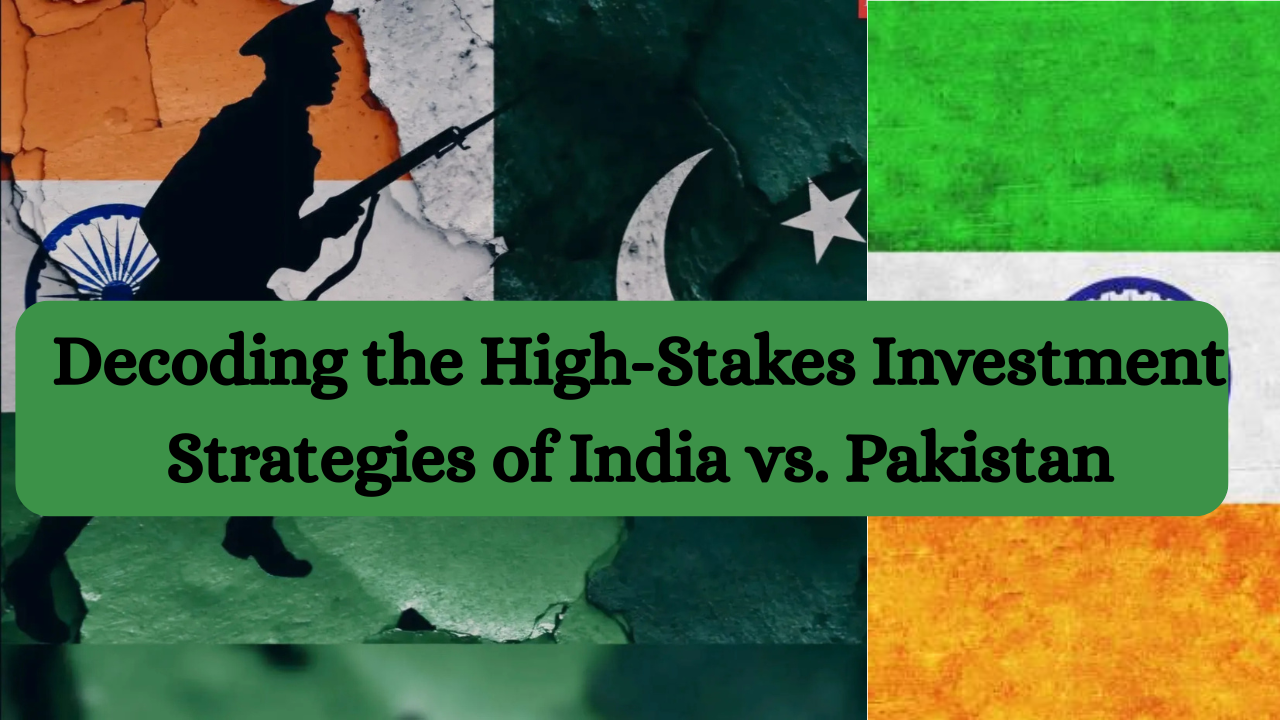The air doesn’t just crackle with excitement; it hums with the palpable frequency of a billion heartbeats synced as one. From the bustling, neon-lit streets of Mumbai to the lively, food-filled lanes of Lahore, a collective pause envelops the subcontinent. An India versus Pakistan cricket match is not merely a sporting event. It is a national referendum on pride, a cultural phenomenon, and for the astute observer, something far more profound: a live, unfiltered masterclass in high-stakes investment strategy.The Pitch and The Portfolio: Decoding the High-Stakes Investment Strategies of India vs. Pakistan
Beneath the surface of the roaring crowds and the soaring sixes lies a complex ecosystem of risk, reward, volatility, and emotional discipline. The twenty-two yards of the pitch transform into a dynamic market floor. Each player becomes a tradable asset, every over a market cycle, and every partnership a bullish trend. To watch this match only as a fan is to see only the ticker tape. To watch it as an analyst is to understand the entire market. This is an exploration of that very analogy—a deep dive into how the clash of these two cricketing giants mirrors the eternal dance of the investor.
Section 1: Building the Core Portfolio – The Blue-Chip Stocks
Every wise investor begins by constructing the foundation of their portfolio with blue-chip stocks. These are the giants—companies with a long history of stability, reliability, and consistent performance. They may not always provide explosive, overnight growth, but they are the bedrock upon which confidence is built. They are the assets you trust to weather a storm.
On the cricket field, the blue-chip stocks are the team’s pillars. For India, the quintessential blue-chip has long been Virat Kohli. He is the equivalent of a premium, multinational conglomerate. Investing in Kohli isn’t about betting on a flashy startup; it’s about trusting a proven brand. His technique is sound, his temperament is tested, and his track record speaks for itself. When the market is volatile—when the bowling is fierce and wickets are falling—you look to your blue-chip to steady the ship. A Kohli cover drive is like a reliable dividend payout; it may not make headlines for its innovation, but it consistently adds value to the scoreboard. He is the foundation of the Indian batting portfolio.
From Pakistan, the corresponding blue-chip is Babar Azam. He represents a different kind of blue-chip—perhaps a prestigious, homegrown champion known for its elegance and class. Babar’s value lies in his impeccable technique and serene consistency. He is the anchor, the player who builds his innings with the meticulous care of a long-term investor compounding interest. He doesn’t chase risky shots; he accumulates value, ball by ball, run by run. In a high-pressure match where emotions are the biggest adversary, Babar’s calm demeanor is his most valuable asset, much like a stable, well-managed company in a turbulent economy.

The bowling attack has its blue-chips too. Jasprit Bumrah is India’s premium asset. He is like investing in cutting-edge technology or defense infrastructure—expensive, high-impact, and capable of single-handedly disrupting the opposition’s strategy. His unique action and lethal yorkers are his competitive moat, making him impossible to replicate. You invest in Bumrah for breakthrough returns, especially in the death overs, which are the market’s most volatile periods.
For Pakistan, Shaheen Afridi occupies a similar space. The left-arm angle, the swing, and the pace represent a disruptive, innovative force. He is the high-growth tech stock within the blue-chip category—established enough to be reliable but still possessing the explosive potential to change the game in a single over. His first spell with the new ball is like an IPO; it sets the tone for everything that follows.
The Investment Lesson: A portfolio overly reliant on speculative assets will crumble under pressure. A strong core of reliable performers is non-negotiable. It is the bedrock that allows you to take calculated risks elsewhere.
Section 2: The High-Risk, High-Reward Gambles – The Growth Stocks & Speculative Bets
If blue-chips are the foundation, then growth stocks and speculative bets are the engine of exponential returns. These are the players who operate on the frontier of risk. Their value is not in consistent stability but in their explosive, game-changing potential. They are the talk of the town, the players who make fans lean in with every ball.
Suryakumar Yadav is India’s ultimate growth stock. He is the embodiment of a Silicon Valley disruptor. His gameplay is innovative, unorthodox, and defies traditional cricketing textbooks. Investing in Suryakumar is a high-risk, high-reward strategy. He could get out on the first ball, rendering your investment worthless for that day. Or, he could play a innings of such breathtaking audacity that it redefines the match’s outcome and sends his “stock price” soaring. His 360-degree shot-making is like a revolutionary new product—it can capture the entire market in a very short time.
Pakistan’s answer to this is the mercurial Mohammad Rizwan in T20s, or the raw talent of a young fast bowler like Naseem Shah. Rizwan’s aggressive consistency at the top is a aggressive growth strategy, while Naseem’s sheer pace is a speculative bet on pure potential.
Then there are the pure speculative penny stocks—players who might have been out of form or are new to the scene. Their past performance charts are erratic. Investing in them is a huge gamble. But on the day of an India-Pakistan match, the potential for a comeback story or a rookie’s dream debut is immense. The payoff can be legendary, turning an unknown name into a national hero overnight. However, the likelihood of failure is equally high.
The Investment Lesson: A smart portfolio allocates only a portion of its capital to these high-risk assets. You never bet the farm on a single speculative idea, no matter how promising it seems. You diversify your risk across asset classes.
Section 3: Market Psychology and Emotional Volatility
This is perhaps the most direct parallel between the match and the market. An India-Pakistan game is a perfect case study in behavioral finance, which examines how psychology influences investors and markets.
The opening partnership is a bull market. Confidence is high, the runs are flowing, and sentiment is overwhelmingly positive. Fans and players alike feel invincible. This is when investors (batsmen) might become overconfident, taking risks they wouldn’t normally consider, like playing a lofted shot too early.
Then comes the first wicket. This is a sudden market correction. A jolt of reality. Panic, often irrational, sets in. The new batsman walks in not just to face a bowler, but to face the weight of that plummeting sentiment. The crowd goes quiet. The pressure mounts. This is the moment that separates the emotional investor from the disciplined one. The emotional investor (player) plays a reckless shot to quickly “recoup the losses,” often leading to another wicket—a full-blown market crash.
A middle-overs partnership is the market slowly regaining its footing. It’s a period of consolidation. The flashy shots are minimized. The focus is on rotating the strike—taking steady, single-point returns—and building a solid foundation again. It’s not glamorous, but it is essential for recovery.
The death overs (the final 4-5 overs of an innings) are the peak of market volatility. It’s like the last hour of a trading day for a day trader. Everything is amplified. Every dot ball is a loss. Every boundary is a massive gain. Decision-making has to be lightning-fast and incredibly precise. Do you go for a six (a high-risk option trade) or settle for a double (a safe, steady mutual fund)? One mistake here can wipe out the gains of the entire previous session. One success can set an unassailable target.
The Investment Lesson: The market is a pendulum that forever swings between unsustainable optimism and unjustified pessimism. The smart money knows this. They don’t get swept away in the euphoria of a six (a rising stock) or the despair of a wicket (a falling one). They stick to their process, trusting their analysis over the crowd’s emotion.
Section 4: Sectoral Analysis – Breaking Down the Game Phases
A modern analyst doesn’t just look at the market as a whole; they break it down into sectors. Similarly, a cricket innings is divided into distinct phases, each with its own rules and optimal strategies.
- The Powerplay (Overs 1-6): The NASDAQ/Technology Sector. This phase is characterized by high aggression, innovation, and potential for rapid growth. The fielding restrictions are in place, allowing for maximum returns on well-executed shots. Batsmen look to capitalize, much like tech stocks soaring on good news. However, the risks are also highest, with fewer fielders out meaning a mistimed shot has a higher chance of being caught. It’s a sector for the aggressive investors.
- The Middle Overs (Overs 7-15): The Value Investing & Consumer Staples Sector. The frenzy dies down. The field spreads out. This is the phase of patience, accumulation, and finding value. It’s less about explosive boundaries and more about working the ball into gaps for ones and twos—the equivalent of steady, dividend-paying stocks. It’s not always thrilling, but it’s where matches are often won or lost. It requires discipline, a trait every value investor swears by.
- The Death Overs (Overs 16-20): The Derivatives & Cryptocurrency Market. This is pure, unadulterated volatility. It’s the realm of complex financial instruments where fortunes are made and lost in seconds. It requires specialized skills. Bowlers try to execute high-pressure yorkers and slower balls (complex option strategies), while batsmen practice scoop shots and ramps (high-leverage bets). It’s chaotic, thrilling, and not for the faint of heart. A single mistake here is catastrophic, but perfect execution can be glorious.
Conclusion: Crafting Your Winning Investment Strategy
As the final ball is bowled and the result is etched into history, the lessons remain. The India-Pakistan cricket match teaches us that success, whether on the pitch or in the markets, is never accidental. It is the product of strategy, discipline, and emotional control.
It teaches us the value of a diversified portfolio. You cannot win with only batsmen or only bowlers. You need a balanced mix of reliable anchors and explosive match-winners.
It underscores the paramount importance of risk management. Even your best batsman can have a bad day. Do you have a plan B? Is your portfolio resilient enough to survive a sudden collapse?
Most importantly, it is the ultimate teacher of emotional discipline. The crowd will roar, the pressure will mount, and the temptation to make an impulsive decision will be overwhelming. The champions are those who can block out the noise, stick to their process, and execute their skills under fire.
So, the next time you sit down to watch an India-Pakistan match, watch it with a new lens. See the blue-chip stocks steadying the innings, the growth stocks taking calculated risks, and the emotional volatility of the market swings. Watch the captains—the portfolio managers—making crucial allocation decisions. You will be witnessing more than just a game. You will be watching a timeless drama of investment philosophy play out in real-time, under the brightest lights and with the highest stakes imaginable. And the lessons you learn might just be the most valuable returns you take away.New chat
